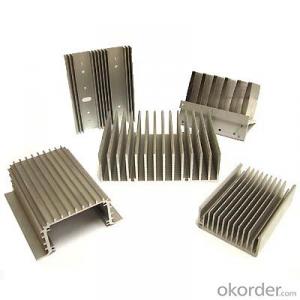Aluminium Profile WINDOWS & DOORS Extrusion
- Loading Port:
- China Main Port
- Payment Terms:
- TT OR LC
- Min Order Qty:
- -
- Supply Capability:
- -
OKorder Service Pledge
Quality Product, Order Online Tracking, Timely Delivery
OKorder Financial Service
Credit Rating, Credit Services, Credit Purchasing
You Might Also Like
Aluminium profile
1) Alloy: AA6061, AA6063
2) Temper: T5, T6
3) Series of surface treament:
1. Mill Finished
2. Anodizing: Silver, champagne, light bronze, dark bronze, black, light titanium, dark titanium.
3. Electrophoretic Coating: Silver, champagne, bronze, black, light bronze, dark bronze.
4. Electrostatic Color Powder Coating: Normal color, special color.
5. Fluorocarbon Powder Spraying: Normal color, special color.
6. Wood Grain Coating: Import paper, domestic paper.

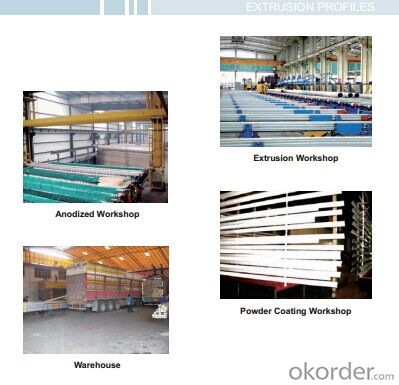
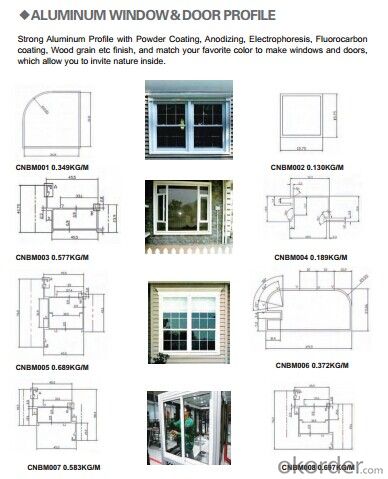
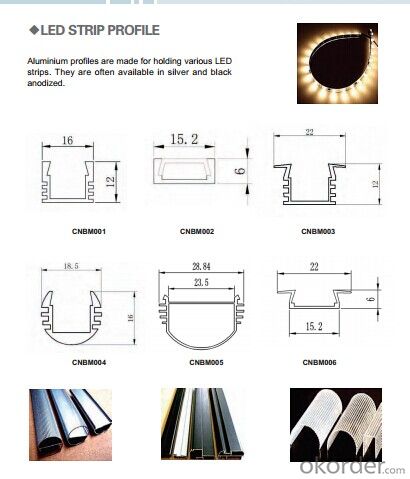

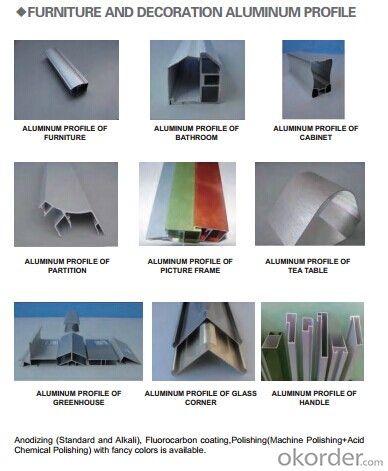
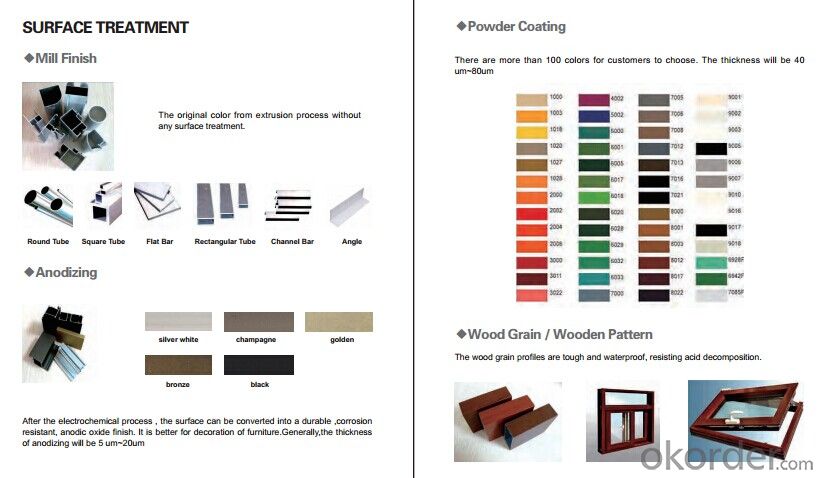
- Q:What is the difference between aluminum profile and sheet metal?
- Aluminum extrusions can be produced by extrusion or casting. In contrast, the aluminum sheet is flat, mainly for all types of surface.
- Q:What are the different fastening options available for aluminum profiles?
- Some of the different fastening options available for aluminum profiles include screws, bolts, nuts, rivets, and adhesive bonding.
- Q:What are the applications of aluminum profiles?
- Aluminum profiles have a wide range of applications across various industries. They are commonly used in construction for window frames, door frames, curtain walls, and roofing systems due to their lightweight, durability, and corrosion resistance. In the automotive industry, aluminum profiles are utilized in the manufacturing of vehicle frames, body panels, and heat exchangers, contributing to improved fuel efficiency. Additionally, these profiles find application in the production of furniture, industrial machinery, electrical enclosures, and transportation systems.
- Q:What are the different surface polishing options for aluminum profiles?
- There are several surface polishing options for aluminum profiles, including mechanical polishing, chemical polishing, electro-polishing, and anodizing. Mechanical polishing involves the use of abrasive materials to remove imperfections and create a smooth surface. Chemical polishing uses chemical solutions to dissolve a thin layer of aluminum and produce a polished finish. Electro-polishing uses an electric current to remove surface imperfections and create a shiny surface. Anodizing is a process in which a protective oxide layer is formed on the surface of the aluminum, providing both a polished appearance and enhanced corrosion resistance.
- Q:How do aluminum profiles perform in terms of energy efficiency?
- Aluminum profiles possess outstanding energy efficiency properties, making them widely utilized in numerous industries and applications, including construction, transportation, and manufacturing. Their ability to contribute to energy savings and sustainability is well-known. The lightweight nature of aluminum is one of the key reasons for its energy efficiency. In comparison to materials like steel, aluminum profiles are considerably lighter, resulting in reduced energy requirements for transportation and installation. This, in turn, decreases the overall carbon footprint associated with the manufacturing and use of aluminum profiles. Furthermore, aluminum exhibits high thermal conductivity, enabling efficient heat transfer. This characteristic proves particularly advantageous in windows and doors applications. By efficiently regulating the transfer of heat between a building's interior and exterior, aluminum profiles diminish the need for excessive heating or cooling, thereby leading to energy savings and reduced energy consumption. Moreover, aluminum profiles readily integrate with additional energy-efficient components, such as thermal breaks and insulating materials. These additions further enhance the energy performance of aluminum profiles by minimizing thermal bridging and enhancing insulation, thereby reducing energy loss. Additionally, aluminum is an extremely durable and long-lasting material. This durability translates to structures and products made with aluminum profiles requiring less maintenance and replacement over time. Consequently, this attribute contributes to overall energy efficiency by reducing the energy and resources needed for repairs and replacements. In conclusion, aluminum profiles are highly esteemed for their energy efficiency characteristics. Their lightweight nature, excellent thermal conductivity, compatibility with energy-efficient components, and long-term durability make them a sustainable choice that can foster energy savings and minimize environmental impact across various applications.
- Q:How is the thickness of the base plate of the aluminum profile radiator calculated? Are there formulas for calculation?
- There should be empirical formula, the heat of the surface heat dissipation is related to thermal conductivity, thickness, temperature change, surface area. Then the best thickness is calculated by linear programming.
- Q:Can aluminum profiles be used for stage and event structures?
- Stage and event structures can indeed make use of aluminum profiles. Aluminum, being both lightweight and durable, is a widely utilized material in the construction industry for a range of purposes, including stage and event structures. Aluminum profiles possess versatility, allowing for easy shaping, cutting, and joining to create customized structures. With an excellent strength-to-weight ratio, they are well-suited for supporting heavy equipment and ensuring the safety of performers and audience members. Moreover, aluminum profiles can be powder-coated or anodized, providing both a decorative finish and protection against corrosion. This enhances the visual appeal and longevity of the structures. In conclusion, aluminum profiles are a popular option for stage and event structures due to their versatility, strength, and aesthetic qualities.
- Q:How do you prevent galling or seizing with aluminum profiles?
- To avoid galling or seizing in aluminum profiles, several steps can be taken: 1. Apply lubricant: Use a suitable lubricant on the contact surfaces of the profiles. This reduces friction and heat, preventing galling or seizing. Be sure to choose a lubricant specifically made for aluminum to avoid any negative reactions. 2. Utilize surface treatments: Implement anodizing or protective coatings on the profiles. These treatments create a barrier between the profiles, minimizing direct metal-to-metal contact and decreasing the likelihood of galling or seizing. 3. Ensure proper design and materials: Make sure the profiles and their mating components have sufficient clearance and a proper fit. Avoid tight tolerances that can cause excessive contact pressure, which increases the risk of galling. Additionally, select materials with compatible hardness and avoid using dissimilar metals that may lead to galvanic corrosion. 4. Keep things clean: Maintain cleanliness by regularly cleaning the profiles and their mating surfaces, removing any dirt, debris, or contaminants. Foreign particles can increase friction and contribute to galling or seizing. 5. Implement regular maintenance: Establish a preventive maintenance program that includes periodic inspection, cleaning, and lubrication of the profiles. This helps identify any issues early on and ensures smooth operation over time. By following these preventive measures, the risk of galling or seizing in aluminum profiles can be minimized, resulting in longer-lasting performance.
- Q:Are there any safety considerations when working with aluminum profiles?
- Yes, there are several safety considerations when working with aluminum profiles. Firstly, aluminum dust and chips can be combustible, so it is important to have proper ventilation and avoid creating sparks or heat sources near the material. Additionally, aluminum profiles can have sharp edges or burrs, which can cause cuts or injuries if not handled carefully. It is advisable to wear appropriate personal protective equipment such as gloves, safety glasses, and a dust mask to prevent any potential hazards.
- Q:How are aluminum profiles joined together?
- Aluminum profiles are commonly joined together using various methods such as welding, screwing, bolting, riveting, or using adhesive bonding techniques. The choice of joining method depends on factors like the specific application, desired strength, aesthetics, and ease of disassembly if necessary.
1. Manufacturer Overview |
|
|---|---|
| Location | |
| Year Established | |
| Annual Output Value | |
| Main Markets | |
| Company Certifications | |
2. Manufacturer Certificates |
|
|---|---|
| a) Certification Name | |
| Range | |
| Reference | |
| Validity Period | |
3. Manufacturer Capability |
|
|---|---|
| a)Trade Capacity | |
| Nearest Port | |
| Export Percentage | |
| No.of Employees in Trade Department | |
| Language Spoken: | |
| b)Factory Information | |
| Factory Size: | |
| No. of Production Lines | |
| Contract Manufacturing | |
| Product Price Range | |
Send your message to us
Aluminium Profile WINDOWS & DOORS Extrusion
- Loading Port:
- China Main Port
- Payment Terms:
- TT OR LC
- Min Order Qty:
- -
- Supply Capability:
- -
OKorder Service Pledge
Quality Product, Order Online Tracking, Timely Delivery
OKorder Financial Service
Credit Rating, Credit Services, Credit Purchasing
Similar products
New products
Hot products
Related keywords



